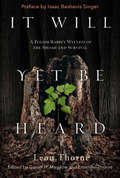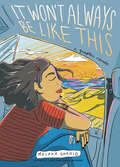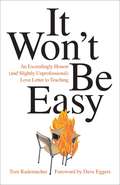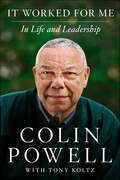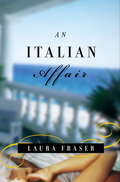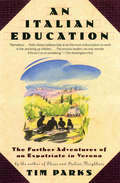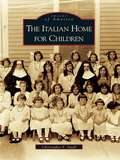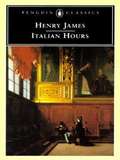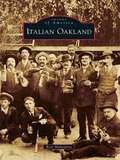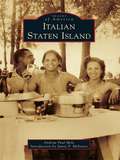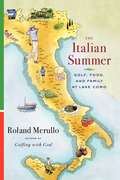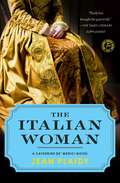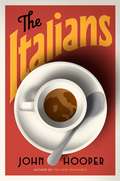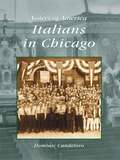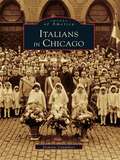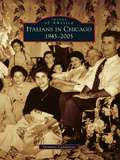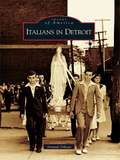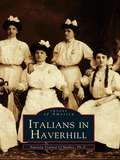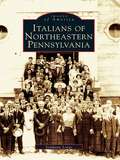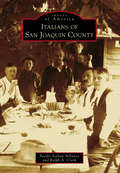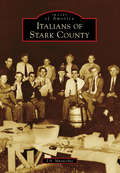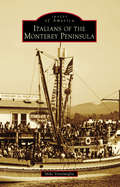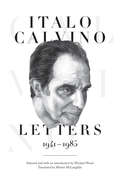- Table View
- List View
It Will Yet Be Heard: A Polish Rabbi's Witness of the Shoah and Survival
by Leon ThorneNobel laureate Isaac Bashevis Singer once described Dr. Leon Thorne’s memoir as a work of “bitter truth” that he compared favorably to the works of Tolstoy, Dostoevsky, and Proust. Out of print for over forty years, this lost classic of Holocaust literature now reappears in a revised, annotated edition, including both Thorne’s original 1961 memoir Out of the Ashes: The Story of a Survivor and his previously unpublished accounts of his arduous postwar experiences in Germany and Poland. Rabbi Thorne composed his memoir under extraordinary conditions, confined to a small underground bunker below a Polish peasant’s pigsty. But, It Will Yet Be Heard is remarkable not only for the story of its composition, but also for its moral clarity and complexity. A deeply religious man, Rabbi Thorne bore witness to forced labor camps, human degradation, and the murders of entire communities. And once he emerged from hiding, he grappled not only with survivor’s guilt, but also with the lingering antisemitism and anti-Jewish violence in Poland even after the war ended. Harrowing, moving, and deeply insightful, Rabbi Thorne’s firsthand account offers a rediscovered perspective on the twentieth century’s greatest tragedy.
It Won't Always Be Like This: A Graphic Memoir
by Malaka GharibAn intimate graphic memoir about an American girl growing up with her Egyptian father&’s new family, forging unexpected bonds and navigating adolescence in an unfamiliar country—from the award-winning author of I Was Their American Dream. &“What a joy it is to read Malaka Gharib&’s It Won&’t Always Be Like This, to have your heart expertly broken and put back together within the space of a few panels, to have your wonder in the world restored by her electric mind.&”—Mira Jacob, author of Good Talk: A Memoir in Conversations ONE OF THE BEST BOOKS OF THE YEAR: Book RiotIt&’s hard enough to figure out boys, beauty, and being cool when you&’re young, but even harder when you&’re in a country where you don&’t understand the language, culture, or social norms. Nine-year-old Malaka Gharib arrives in Egypt for her annual summer vacation abroad and assumes it'll be just like every other vacation she's spent at her dad's place in Cairo. But her father shares news that changes everything: He has remarried. Over the next fifteen years, as she visits her father's growing family summer after summer, Malaka must reevaluate her place in his life. All that on top of maintaining her coolness!Malaka doesn't feel like she fits in when she visits her dad--she sticks out in Egypt and doesn't look anything like her fair-haired half siblings. But she adapts. She learns that Nirvana isn't as cool as Nancy Ajram, that there's nothing better than a Fanta and a melon-mint hookah, and that her new stepmother, Hala, isn't so different from Malaka herself. It Won&’t Always Be Like This is a touching time capsule of Gharib&’s childhood memories—each summer a fleeting moment in time—and a powerful reflection on identity, relationships, values, family, and what happens when it all collides.
It Won't Be Easy: An Exceedingly Honest (and Slightly Unprofessional) Love Letter to Teaching
by Tom RademacherTom Rademacher wishes someone had handed him this sort of book along with his teaching degree: a clear-eyed, frank, boots-on-the ground account of what he was getting into. But first he had to write it. And as 2014’s Minnesota Teacher of the Year, Rademacher knows what he’s talking about. Less a how-to manual than a tribute to an impossible and impossibly rewarding profession, It Won’t Be Easy captures the experience of teaching in all its messy glory.The book follows a year of teaching, with each chapter tackling a different aspect of the job. Pulling no punches (and resisting no punch lines), he writes about establishing yourself in a new building; teaching meaningful classes, keeping students a priority; investigating how race, gender, and identity affect your work; and why it’s a good idea to keep an extra pair of pants at school. Along the way he answers the inevitable and the unanticipated questions, from what to do with Google to how to tell if you’re really a terrible teacher, to why “Keep your head down” might well be the worst advice for a new teacher.Though directed at prospective and newer teachers, It Won’t Be Easy is mercifully short on jargon and long on practical wisdom, accessible to anyone—teacher, student, parent, pundit—who is interested in a behind-the-curtain look at teaching and willing to understand that, while there are no simple answers, there is power in learning to ask the right questions.
It Worked for Me: In Life and Leadership
by Colin Powell Tony KoltzNew York Times Bestselling AuthorColin Powell, one of America’s most admired public figures, reveals the unique lessons that shaped his life and careerIt Worked for Me is a collection of lessons and personal anecdotes that shaped four star-general and former Secretary of State Colin Powell’s legendary career in public service. At its heart are Powell’s “Thirteen Rules,”—notes he accumulated on his desk that served as the basis for the leadership presentations he delivered throughout the world.Powell’s short-but-sweet rules such as “Get mad, then get over it” and “Share credit,” are illuminated by revealing personal stories that introduce and expand on his principles for effective leadership: conviction, hard work, and above all, respect for others. In work and life, Powell writes, “It is the human gesture that counts.”A compelling storyteller, Powell shares parables both humorous and solemn that offer wise advice on succeeding in the workplace and beyond. “Trust your people,” he councils as he delegates presidential briefing responsibilities to two junior aides. “Do your best--someone is watching,” he advises those just starting out, recalling his own teenage summer job shipping cases of soda. Powell combines the insight he gained serving in the top ranks of the military and in four presidential administrations, as well as the lessons learned from his hardscrabble upbringing in the Bronx and his training in the ROTC. The result is a powerful portrait of a leader who was reflective, self-effacing, and grateful for the contributions of every employee, no matter how junior.Powell’s writing--straightforward, accessible, and often very funny--will inspire, move, and surprise readers. Thoughtful and revealing, his book is a brilliant and original blueprint for leadership.
An Italian Affair
by Laura FraserWhen Laura Fraser's husband leaves her for his high school sweetheart, she takes off, on impulse, for Italy, hoping to leave some of her sadness behind. There, on the island of Ischia, she meets M., an aesthetics professor from Paris with an oversized love of life. What they both assume will be a casual vacation tryst turns into a passionate, transatlantic love affair, as they rendezvous in London, Marrakech, Milan, the Aeolian Islands, and San Francisco. Each encounter is a delirious immersion into place (sumptuous food and wine, dazzling scenery, lush gardens, and vibrant streetscapes) and into each other. And with each experience, Laura brings home not only a lasting sense of pleasure, but a more fully recovered sense of her emotional and sexual self. Written with an observant eye, an open mind, and a delightful sense of humor, An Italian Affair has the irresistible honesty of a story told from and about the heart.From the Trade Paperback edition.
Italian Days
by Barbara Grizzuti Harrison"Italian Days" is one of the richest and most absorbing travel books written--a journey that traverses the Italian peninsula and immerses readers in a culture which provides the reader with a definition of the good life. "Harrison's wonderful journal will make you update your passport and dream of subletting your job, home, etc. . . . "
An Italian Education: The Further Adventures of an Expatriate in Verona
by Tim ParksA &“marvelous&” Mediterranean memoir of an expatriate father raising his children in Italy—from the author of Italian Neighbors (The Washington Post). Tim Parks offers another lively firsthand account of Italian society and culture—this time focusing on all the little things that turn an ordinary newborn infant into a true Italian. When British-born Tim Parks heard a mother at the beach in Pescara shout to her son, &“Alberto, don&’t sweat! No you can&’t go in the sea till eleven, it&’s still too cold, go and see your cousin in row three number fifty-two,&” he was inspired to write about parenting in Italy—which he was doing himself at the time after adopting the country as his own. In this humorous memoir, Parks offers an enchanting portrait of Italian childhood that shifts from comedy to despair in the time it takes to sing a lullaby. The result is &“a wry, thoughtful, and often hilarious book . . . a parable of how our children, no matter what, are other than ourselves&” (The New Yorker). &“Glimpses of Italy that are fond, critical, pithy and penetrating.&” —The Atlanta Journal-Constitution
An Italian Grows in Brooklyn
by Jerry Della Femina Charles SopkinA funny, touching, and bitter memoir about myths and misconceptions of being Italian American. Within a thirty-year span in the early 19th century, the Delia Femina family nearly empties their Italian village near Naples and migrates to Brooklyn's Gravesend neighborhood in the United States. The Italian's inability to let anyone leave the family meant the family moved intact to the United States as they kept their village habits and customs.
The Italian Home for Children
by Christopher F. SmallAs it ravaged the world, the influenza epidemic of 1918 devastated Boston's congested North End and left hundreds of orphans in its wake. Touched by this crisis, a Roman Catholic priest and a group of Italian Americans founded the first home for Italian children in Massachusetts. Franciscan Sisters devoted 24 hours a day to providing the children with a safe, loving, and spiritual environment. In addition, the home provided educational support for its residents. Over time, the changing needs of children mandated that the agency change the nature of its services from custodial care to treatment. In 1974, in response to the changing political and social climate, the agency became the Italian Home for Children. Today, it is a nonprofit, nonsectarian residential treatment facility with a capacity for 61 children of all races, nationalities, and religions. The images in The Italian Home for Children document milestones in the organization's history: the devastating influenza epidemic, the Missionary Franciscan Sisters of the Immaculate Conception, Christmas plays, a visit from Joe DiMaggio, trips to Canobie Lake Park in the summer, the Tony Martin benefit performance at Boston Garden, and the home as it is today--a refuge for children in the most severe crises.
Italian Hours
by Henry JamesIt is a great pleasure to write the word; but I am not sure there is not a certain impudence in pretending to add anything to it. Venice has been painted and described many thousands of times, and of all the cities of the world is the easiest to visit without going there. Open the first book and you will find a rhapsody about it; step into the first picture-dealer's and you will find three or four high-coloured "views" of it. There is notoriously nothing more to be said on the subject. Every one has been there, and every one has brought back a collection of photographs. There is as little mystery about the Grand Canal as about our local thoroughfare, and the name of St. Mark is as familiar as the postman's ring. It is not forbidden, however, to speak of familiar things, and I hold that for the true Venice-lover Venice is always in order. There is nothing new to be said about her certainly, but the old is better than any novelty. It would be a sad day indeed when there should be something new to say. I write these lines with the full consciousness of having no information whatever to offer. I do not pretend to enlighten the reader; I pretend only to give a fillip to his memory; and I hold any writer sufficiently justified who is himself in love with his theme.
Italian Oakland (Images of America)
by Rick MalaspinaOakland, the other city by the bay, was a magnet for Italian immigrants in the early decades of the 20th century. Some relocated from San Francisco after the devastating 1906 earthquake and fire; many more came to Oakland predominantly from Italy's northern regions of Piedmont, Liguria, and Lombardy in search of opportunity and prosperity. These pioneers worked hard, typically at backbreaking labor, to build new lives. They raised a generation of children who succeeded in their own right and contributed in various ways to their community and nation. As they established new roots and adopted new ways, congregating largely in north Oakland's vibrant and bustling Temescal neighborhood, these Italian Americans also nurtured their Old Country customs and traditions--many of which, along with rare glimpses of bygone days, are portrayed in this charming trip through time.
Italian Staten Island (Images of America)
by Andrew Paul Mele James P. MolinaroThe great wave of European immigration in the late 19th and early 20th centuries brought more than four million Italians to America. It was one of the greatest mass emigrations in world history, and many settled in Staten Island. Following the opening of the Verrazano-Narrows Bridge in 1964, the island experienced another great influx of Italian immigrants, this time from the other boroughs of New York City. This new wave was responsible for doubling the island population by the year 2000. Italian Americans are evident in every avocation and in each corner of Staten Island society, with achievers in education, business, government, medicine, and sports and entertainment. Italian Staten Island chronicles the traditions, culture, and heritage of Italian Americans through more than 200 photographs.
The Italian Summer
by Roland MerulloFore, bella! From the author of critically acclaimed Golfing with God comes a charming narrative of a hole-in-one trip through Italy -- a glorious summer of golfing, eating, and learning how to slow down and enjoy life. In the summer of 2007, Roland Merullo was feeling a little burnt out by the frantic pace of his life in the United States and decided to rent an Italian villa near the shore of Lake Como. He arrived in Italy with his wife and two young daughters, hoping the Mediterranean air would teach him to appreciate the more relaxed, Italian way of living: a focus on food, family, and fun. An avid golfer and golf writer, Merullo also set out to enjoy one of Italy's lesser-known treasures: excellent golf on some gorgeous courses. With his customary wit, keen eye, and down-to-earth style, Merullo shares this fascinating account of his summer in Italy, offering detailed and often humorous descriptions of wonderful meals, colorful characters, rounds of golf at some of the most beautiful courses in Europe, and precious time spent with family. The Italian Summer brings to life the myriad joys of Italian existence in a way that all lovers of food, wine, travel, and the proverbial "good walk spoiled" will savor.
The Italian Woman: A Catherine De' Medici Novel (Catherine de Medici #2)
by Jean PlaidyFrom an author who “excels at blending history with romance and drama,” a novel based on the life of the powerful queen, Catherine de’ Medici (The New York Times).When Catherine de’ Medici was forced to marry Henry, Duke of Orleans, her heart was not the only one that was broken. Jeanne of Navarre once dreamed of marrying this same prince, but, like Catherine, she must comply with France’s political needs. And so both Catherine’s and Jeanne’s lives are set on unwanted paths, destined to cross in affairs of state, love, and faith, driving them to become deadly political rivals.Years later Jeanne is happily married to the dashing but politically inept Antoine de Bourbon. But the widowed Catherine is now the ambitious mother of princes, and she will do anything to see her beloved second son, Henry, rule France. As civil war ravages the country and Jeanne fights for the Huguenot cause, Catherine advances along her unholy road, making enemies at every turn.“Plaidy has brought the past to life.” —Times Literary Supplement
The Italians
by John HooperA vivid and surprising portrait of the Italian people from an admired foreign correspondentHow can a nation that spawned the Renaissance have produced the Mafia? How could people concerned with bella figura (keeping up appearances) have elected Silvio Berlusconi as their leader--not once, but three times? Sublime and maddening, fascinating yet baffling, Italy is a country of seemingly unsolvable riddles.John Hooper's entertaining and perceptive new book is the ideal companion for anyone seeking to understand contemporary Italy and the unique character of the Italians. Digging deep into their history, culture, and religion, Hooper offers keys to understanding everything from their bewildering politics to their love of life and beauty. Looking at the facts that lie behind the stereotypes, he sheds new light on many aspects of Italian life: football and Freemasonry, sex, symbolism, and the reason why Italian has twelve words for a coat hanger, yet none for a hangover.Even readers who think they know Italy well will be surprised, challenged, and delighted by The Italians.
Italians in Chicago: 1945-2005 (Voices of America)
by Dominic CandeloroThe stories of Chicago's Italian communities are an important part of the rich and diverse mosaic of Chicago history. As a rail center, an industrial center, and America's fastest growing major city, Chicago offered opportunities for immigrants from all nations. Italians in Chicago presents an intriguing narrative record of the earliest beginnings of Italian communities in the city, going back to the 1850s. It explores the lives of ten significant members of the Chicago Italian-American community.This book is a collaborative, cumulative effort, and gives glimpses and echoes of what occurred in the Italian-American past in Chicago. Including vintage images and tales of such individuals as Father Armando Pierini, Anthony Scariano, and Joe Bruno, and groups such as the Aragona Club and the Maria Santissima Lauretana Society, this collection uncovers the challenges and triumphs of these Italian immigrants.
Italians in Chicago: 1945-2005 (Images of America)
by Dominic CandeloroThe stories of Chicago's Italian communities are an important part of the rich and diverse mosaic of Chicago history. As a rail center, an industrial center, and America's fastest growing major city, Chicago offered opportunities for immigrants from all nations. Italians in Chicago presents an intriguing narrative record of the earliest beginnings of Italian communities in the city, going back to the 1850s. It explores the lives of ten significant members of the Chicago Italian-American community.This book is a collaborative, cumulative effort, and gives glimpses and echoes of what occurred in the Italian-American past in Chicago. Including vintage images and tales of such individuals as Father Armando Pierini, Anthony Scariano, and Joe Bruno, and groups such as the Aragona Club and the Maria Santissima Lauretana Society, this collection uncovers the challenges and triumphs of these Italian immigrants.
Italians in Chicago: 1945-2005 (Images of America)
by Dominic CandeloroMore than 25,000 Italian immigrants came to Chicago after 1945. The story of their exodus and reestablishment in Chicago touches on war torn Italy, the renewal of family and paesani connections, the bureaucratic challenges of the restrictive quota system, the energy and spirit of the new immigrants, and the opportunities and frustrations in American society. Drawn from scores of family albums, these intimate snapshots tell the story of the unique and universal saga of immigration, a core theme in American and Italian history.
Italians in Detroit (Images of America)
by Armando DelicatoPeople of Italian descent have been present in Detroit since Alfonso Tonti, second-in-command to Antoine Cadillac, participated in the founding of the city in 1701. By the close of the 19th century, the trickle of Italian immigrants had become a torrent, as thousands rushed to the growing industrial center. Settling on the lower east side, the community grew rapidly, especially north and east into Macomb County. Italians in Detroit did not remain in a "little Italy," but mingled with the diverse population of the city. Through a combination of hard work and strong family and community ties, the Italians of Detroit have achieved their dreams of a better life. They have met the challenges of living in a new land while nurturing the culture of the old country. The challenge that remains is to nurture a love ofheritage among young Italian Americans as the immigrant generation fades.
Italians in Haverhill
by Patricia Trainor O’malleyItalian immigrants became permanent residents of Haverhill in the 1870s. The original Genoese first drew their relatives and friends from their home area to join them. Over the next few decades, they were joined by families from the central province of Abruzzi and from the towns and villages around Naples. Immigrants from parts of southern Italy, such as Calabria and Apulia and Sicily, settled here. All of the Italians, whether northern or southern, brought with them their culture, their vitality, their love of music, and their close family ties. Using over two hundred thirty vintage photographs, Italians in Haverhill takes a photographic walk through the exciting history of these immigrants. The images bring back to life representatives of more than two hundred families, whose descendants still live in the area. Here are the fruit sellers and shoe workers, the mothers and their children, the ball players and the musicians, the lawyers and doctors, and the bankers and civic leaders who make up the rich heritage of this important ethnic group.
Italians of Northeastern Pennsylvania (Images of America)
by Stephanie LongoEvery Labor Day weekend, hundreds of thousands of people flock to Courthouse Square in Scranton for the largest ethnic festival in northeastern Pennsylvania: La Festa Italiana. The Italians of this region have been proudly celebrating their heritage since their arrival in this country with traditional festivals, including La Corsa dei Ceri in Jessup and Dunmore's procession in honor of St. Rocco. Using vintage and recent photographs, Italians of Northeastern Pennsylvania shows how the Italian immigrants to this area, some of whom arrived with little more than the clothes on their back, became well-respected community leaders. Through hard work and dedication, they have made northeastern Pennsylvania into an area that defines the term "ethnic pride."
Italians of San Joaquin County (Images of America)
by Ralph A. Clark Pacific Italian AllianceItalians were among the first European settlers in California, as fishermen from Italy arrived in the 1830s. After gold was discovered in 1848, immigrants from all over the world came for the opportunity that California presented. For the Italians, they encountered a terrain and climate so similar to their homeland that many stayed on to make California their new home. In San Joaquin County, the Italian influence remains profound, with the immigrants and their descendants helping develop the area's cultural, agricultural, and business climate into what it is today. The legacy of the Italian pioneers has enriched San Joaquin County in immeasurable ways. Every aspect of life here has been touched, molded, and made better by this industrious group who came to a distant land to make a better life.
Italians of Stark County (Images of America)
by J. A. MusacchiaImages of America: Italians of Stark County focuses on Italian immigration into Stark County beginning in the late 1800s. At the time, Stark County's urban hub of Canton and the surrounding communities were in the middle of a thriving expansion driven by industry, transportation, and manufacturing. Along with this growth came the need for labor, with immigration filling many of those needs. Italians came to Stark County to work in the steel mills, in the coal mines, and on the railroad, as well as to start their own small businesses. Once established, Italian families began to replicate the community foundations from their native land, and in turn these foundations reinforced embedded values: family, food, religion, music, and freedom.
Italians of the Monterey Peninsula
by Mike VentimigliaSince the early 1900s, Monterey was known for its fishing, mostly for salmon and the abalone that was plentiful in Monterey Bay. The migration of the Sicilian Italian community is credited for reaping what was called the "Silver Harvest." The Silver Harvest is the name that was given to the fishing of sardines in Monterey, which mostly was done by the Sicilian Italians who established the working fabric in the sardine industry for nearly five decades. Most of that generation is gone, and only a few are memorialized in books. It is this author's attempt to capture the working class that made Monterey the "Sardine Capital of the World."
Italo Calvino: Letters, 1941-1985 - Updated Edition
by Italo CalvinoThe first collection of letters in English by one of the great writers of the twentieth centuryThis is the first collection in English of the extraordinary letters of one of the great writers of the twentieth century. Italy's most important postwar novelist, Italo Calvino (1923-1985) achieved worldwide fame with such books as Cosmicomics, Invisible Cities, and If on a Winter’s Night a Traveler. But he was also an influential literary critic, an important literary editor, and a masterful letter writer whose correspondents included Umberto Eco, Primo Levi, Gore Vidal, Leonardo Sciascia, Natalia Ginzburg, Michelangelo Antonioni, Pier Paolo Pasolini, and Luciano Berio. This book includes a generous selection of about 650 letters, written between World War II and the end of Calvino’s life. Selected and introduced by Michael Wood, the letters are expertly rendered into English and annotated by well-known Calvino translator Martin McLaughlin.The letters are filled with insights about Calvino’s writing and that of others; about Italian, American, English, and French literature; about literary criticism and literature in general; and about culture and politics. The book also provides a kind of autobiography, documenting Calvino’s Communism and his resignation from the party in 1957, his eye-opening trip to the United States in 1959-60, his move to Paris (where he lived from 1967 to 1980), and his trip to his birthplace in Cuba (where he met Che Guevara). Some lengthy letters amount almost to critical essays, while one is an appropriately brief defense of brevity, and there is an even shorter, reassuring note to his parents written on a scrap of paper while he and his brother were in hiding during the antifascist Resistance.This is a book that will fascinate and delight Calvino fans and anyone else interested in a remarkable portrait of a great writer at work.
